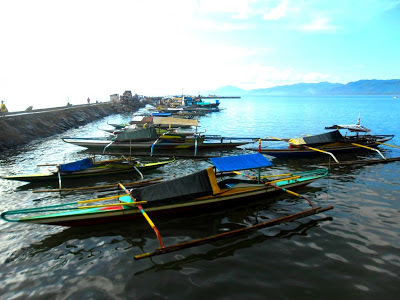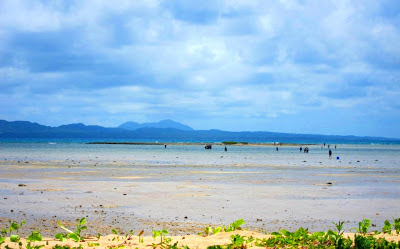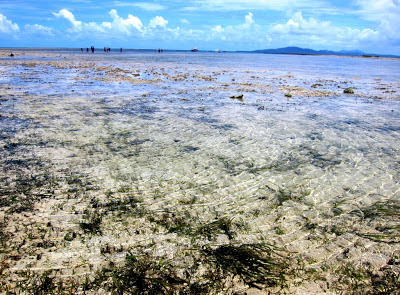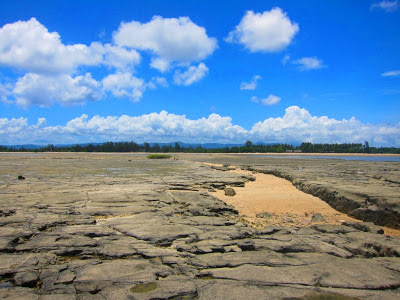What is something that I will miss in the Andes? The cold despite the intense sun. And the clear blue sky. And what did I learn? Sometimes things look better naked. (And by that I mean the landscape with sparse vegetation.)
Day 3: The never-ending lakes and the salt hotel
I had some trouble sleeping the night before (most likely) because the altitude made me gasping for air the whole time. And the pillow in our room, which was close to non-existent didn't help at all. (Now I know that I should bring an inflatable pillow the next time I go on a trip) But the clear-blue Andes sky seemed to promise another epic day despite the cold. It was time to head north to the
salar.
We exited the Eduardo Avaroa Reserve after the guard checked that we have our passes as proof that we already paid the entrance fee. (Yes, visitors must keep that piece of paper they give after payment. Losing it means another 150Bs from your pocket just to exit the reserve.) We drove through the dusty desert to get to
Arbol de Piedra in the
Desierto Siloli. There were lots of rock formations scattered in the area but this one takes the highlight because of its tree-like shape.
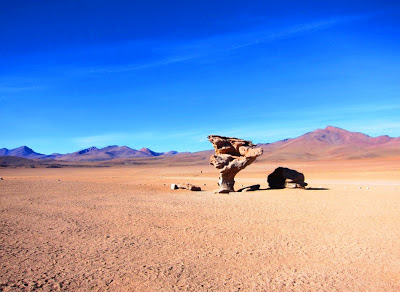 |
| Showcasing the power of wind, Arbol de Piedra. No climbing, please. |
As I walked between the rock formations, I kept thinking of water. It wasn't until a few days that I realized we were in a desert where water is scarce; ergo, wind. The place was shaped by eolian processes! I would have had a woah!-moment if only I had realized it earlier. It is simply mind-blowing. Okay, I know it by theory. But if I could live eternally, I'll probably spend some thousands of years watching how the elements of nature slowly creates these majestic landscapes.
We hopped into our vehicle and continued driving until we reached our first lake for the day. Everyone was at awe. The tranquil (shallow) Laguna Honda created a perfect reflection of the distant snow-peaked mountains. We stayed there for some time, going around, snapping pictures and me making some shoe prints on the borax precipitates around the lake.
 |
| Laguna Honda. |
There were too many lakes in southwest Bolivia. We skipped at least two smaller lakes, white- and yellow-colored, along the way and headed straight to Laguna I'm-not-so-sure-about-its-name where there were some facilities. Thank god for the toilet though it costed me 10Bs. There were lots of feeding flamingos in that lake and it was time again to take photos of them.
 |
| James's flamingo. |
Here's something worth-noting. Out of the six species of flamingos in the world, three are found in the southwest Bolivia. Andean flamingo is the largest of the three with pink plumage, yellow legs and black-and-pale yellow bills. Chilean flamingo has salmon-colored plumage, grey legs with pink/red joints and white-and-black bills. James's flamingo is the smallest of the three species, with pink plumage, red legs, yellow-and-black bills and red skin near the eyes.
Of the three species, I think I only saw the James's flamingo. I scoured my photos to find the two other species but failed. They were probably on the farther side of the lake. Wish I had a camera with 50x optical zoom. It would have been perfect for spying....flamingos. Haha!
We were supposed to stop at another blue lake but everyone preferred to stay inside the vehicle. I just asked someone else to take a photo for me. Don't get me wrong. The scenery was very lovely; if only we hadn't seen so many lakes prior to that one. Or at least if we had seen it on another day. I guess there comes a point when one gets tired of beauty when it has nothing else to offer. In our case, a lake is still a lake, unless the feeding flamingos start dancing. Variety was something that we needed to spike our interest.
So it was actually a good decision to ditch Laguna Negra. It wasn't part of the itinerary anyway. Our drivers told us on the first night that Laguna Verde (which was supposed to be really beautiful) wasn't green that time. For some reasons, it had turned brown. And since we were only going there to witness its green color, we agreed on seeing the black lake instead. But on the second night, the drivers changed our agreed itinerary again and said that if we see the black lake, we will end up near the town of Uyuni and not be able to sleep in a salt hotel. Of course we preferred the other option so off we went to the salt hotel.
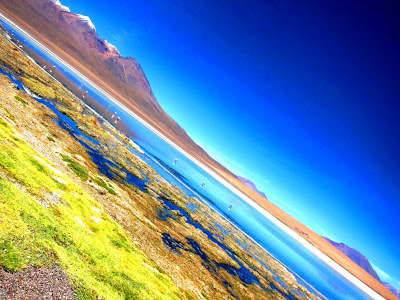 |
| Inclined horizon. To break the monotony. (Photo taken by David.) |
It was a very long drive to get to the salt hotel. We stopped for lunch in another strange-looking place. The rocks were just lava flows but they looked more interesting after weathering and erosion. And because of those moss-like plants that fooled me.
I was looking for a good spot to sit while eating with the group. There was only one I liked and there was this plant that looked like a moss. I told myself it was just moss. Haha! But when I looked at it closer (while sitting on it) I realized it wasn't moss at all and it wasn't just enveloping rocks. The whole mound was made of the plant and it was unbelievably as hard as a rock. It turns out to be a
yareta, a flowering plant that grows only in Bolivia, Peru, Argentina and Chile at altitudes of 3200 to 4500m. (So I can't grow it in my garden?) The
yareta is extremely compact so that it will keep as much heat from escaping as possible for the really cold nights in the Andes. The plant was used by local people as fuel for cooking but it is now prohibited to gather it for fear that they will soon get extinct.
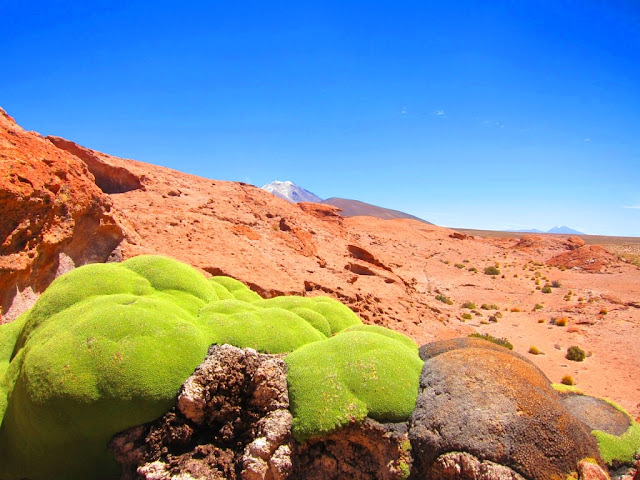 |
| Yareta. The 'dead' part (without leaves) looked like corals. Promise. |
It took us more than three hours to get to the salt hotel where we would spend the night. We drove through vast empty lands occasionally passing through some small villages growing quinoa. Interestingly, the rows of quinoa in the farms were planted in such a way that as they grow, their colors resemble the Bolivian flag. (I was busy finding a place to pee I didn't take a picture but here's a link to my friend's
photo.) We also crossed a railway in god-knows-where whose main purpose is for transporting minerals from Bolivia to Chile. It looked like a place where even ghosts wouldn't bother reside.
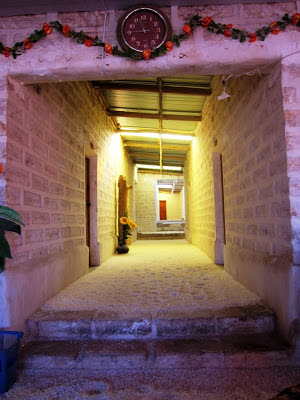 |
| The salt hotel. |
Some groups have reached the salt hotel before us and when we got there, they told us that we were the first ones to wander on that side of the
salar for the year. (Some bragging rights then?) Rains during the summer season flood the salt flats making it difficult, if not impossible to cross to Uyuni from there. It was just nearing the end of summer so in way we were risking getting trapped in that place in case the waters were still too high for the 4x4 to cross. The salt hotel staff probably didn't anticipate our coming because they were still cleaning and preparing the rooms when we got there. And that may be the reason why there was some cat poop in our room. Ugh!
The hotel was almost entirely made of salt. From the floor, to the walls, the bed (nothing to worry, there's mattress), tables and chairs. They even have decors hanging from the ceiling made of salt. The shower was the only exception. And yes! there was shower. I was finally able to get a hot bath after three days albeit hurried because there was only one shower and hot water was just until 9 in the evening.
After having dinner, the drivers came to give us the bad news and the good news. Good news: there was just enough water to see the reflection of the sky and safely cross the salt flats. Bad news: it was too far to go out that night so no star-gazing (look both up and down to see the stars) for us. No problem, it wasn't part of the original itinerary anyway. And we were supposed to leave very early the next day to see the sunrise in the
salar and I'd rather our drivers be well-rested after driving on what seemed to be endless roads to the hotel
. I just went out for a few minutes to look at the stars. It was cloudy. It was time to sleep.
 If not for the rocks, lumps of soil and tree stumps blocking the road (and the fact that we had to walk) it wouldn't seem like there was a strike (at least it was unlike here in the Philippines). The place was serene and I didn't feel any kind of tension at all. I even saw a soccer game held in one of the small villages. Travel guides advise tourists not to try to cross these road blocks. But the many groups of locals holding the strike whom I saw along the road didn't mind us. An old man even walked and chatted with me.
If not for the rocks, lumps of soil and tree stumps blocking the road (and the fact that we had to walk) it wouldn't seem like there was a strike (at least it was unlike here in the Philippines). The place was serene and I didn't feel any kind of tension at all. I even saw a soccer game held in one of the small villages. Travel guides advise tourists not to try to cross these road blocks. But the many groups of locals holding the strike whom I saw along the road didn't mind us. An old man even walked and chatted with me.










